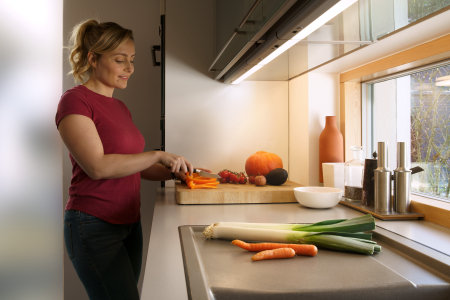Life usually centres around the kitchen: preparing, cooking, chatting. And all this requires different light conditions depending on the particular area of the kitchen and, of course, your needs. You can be as creative with modern LED kitchen lighting as you are with your cooking – and nothing gets burnt. And what’s more, energy-saving lighting also ensures that your electricity costs fall.
 IMPORTANT ELEMENTS
IMPORTANT ELEMENTSThe most important elements of lighting:
Your work area with storage, oven and sink needs to be very well lit. On the one hand it is important to avoid accidents while cutting or chopping, and on the other hand to avoid straining your eyes. After all, insufficient light is considered bad for the eyes. On a cooking island spots in the ceiling provide enough light. For traditional kitchens with wall cabinets, LED lighting is an excellent choice. Either long strips of light or individual LED spots are integrated into the underside of the wall cabinets and illuminate the countertop from above without shading or dazzling.
A suggestion: if you sometimes prepare intricate food, you should use an additional light source that you can position and adjust. If you do not have a free socket, this lighting can be battery-operated. When needed, you can get the light out of the cupboard, clamp it in position and get to work.
1. How many Kelvin does kitchen lighting need?
For the preparation area, lighting should be at least 3,000 Kelvin (normal white) so your eyes do not tire in dim light. For atmospheric LED kitchen lighting on a base unit and the light above a dining table, 2,500 to 2,700 Kelvin (warm white) is sufficient.
2. How many lumens are ideal for kitchen lighting?
The kitchen lighting should be around 300 lumens per square metre. You can distribute individual spots over the ceiling with 300 lumens each, or use a central ceiling lamp with correspondingly more lumens.
 As the kitchen is becoming more and more a comfort zone and place to lounge, decorative kitchen lighting is also playing an increasingly important role. Indirect lighting creates a comfortable atmosphere throughout the room. This can be individual spotlights integrated in the wall units that light the area up to the ceiling, or downlighters built into the worktops that illuminate the lower third of the room.
As the kitchen is becoming more and more a comfort zone and place to lounge, decorative kitchen lighting is also playing an increasingly important role. Indirect lighting creates a comfortable atmosphere throughout the room. This can be individual spotlights integrated in the wall units that light the area up to the ceiling, or downlighters built into the worktops that illuminate the lower third of the room.
More tips:
Achieving the perfect kitchen lighting design is a skilful interaction of different light sources and light colours. Start planning your LED lighting right now!